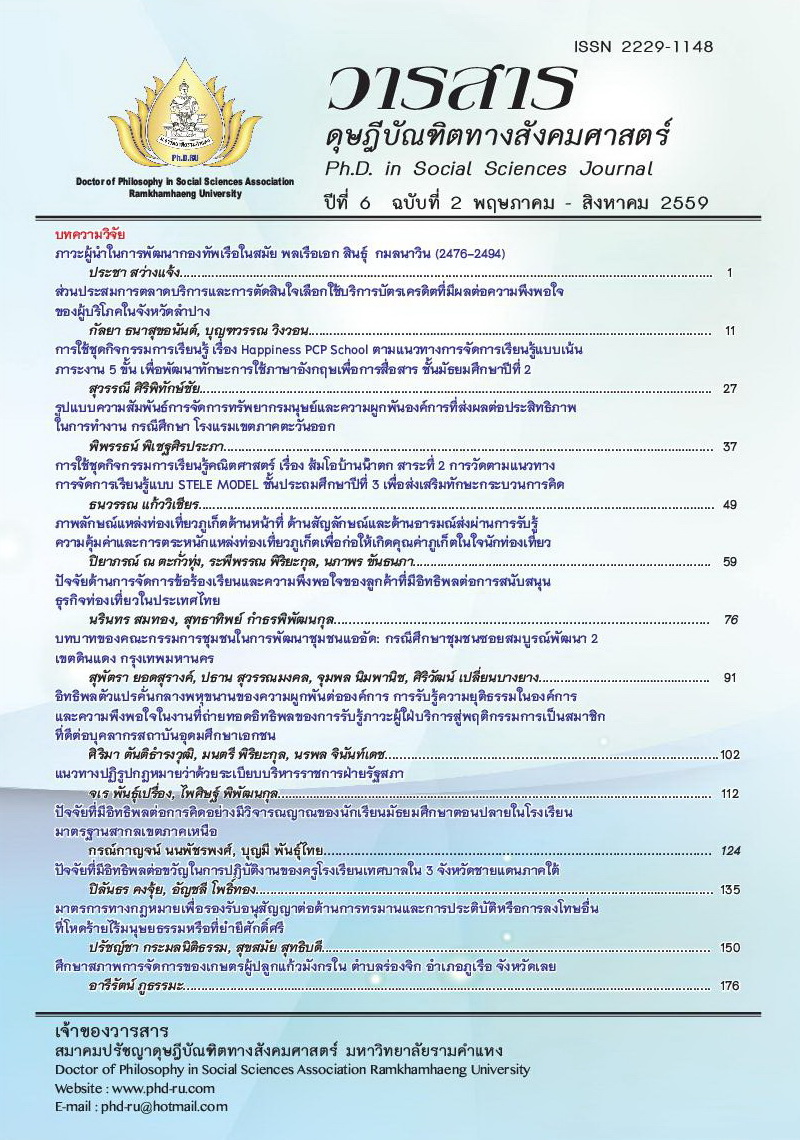ปัจจัยที่มีอิทธิพลต่อการคิดอย่างมีวิจารณญาณของนักเรียนมัธยมศึกษาตอนปลายในโรงเรียนมาตรฐานสากลเขตภาคเหนือ
Main Article Content
Abstract
การวิจัยครั้งนี้มีวัตถุประสงค์เพื่อ (1) ศึกษาลักษณะของปัจจัยที่ส่งผลต่อการคิดอย่างมีวิจารณญาณของนักเรียนมัธยมศึกษาตอนปลายในโรงเรียนมาตรฐานสากลเขตภาคเหนือ (2) ศึกษาอิทธิพลทั้งทางตรงและทางอ้อมของปัจจัยที่มีอิทธิพลต่อการคิดอย่างมีวิจารณญาณของนักเรียนมัธยมศึกษาตอนปลายในโรงเรียนมาตรฐานสากลเขตภาคเหนือโดยการทดสอบแบบจำลองความสัมพันธ์เชิงสาเหตุ ระหว่างตัวแปรพยากรณ์ ได้แก่ เจตคติต่อการเรียน แรงจูงใจใฝ่สัมฤทธิ์ พฤติกรรมการสอนของครู บรรยากาศในชั้นเรียน การอบรมเลี้ยงดูแบบประชาธิปไตย บุคลิกภาพทางวิทยาศาสตร์ ความสามารถด้านเหตุผล และตัวแปรเกณฑ์ คือ การคิดอย่างมีวิจารณญาณของนักเรียน กลุ่มตัวอย่างคือนักเรียนมัธยมศึกษาตอนปลายในโรงเรียนมาตรฐานสากลเขตภาคเหนือ เครื่องมือที่ใช้ในการวิจัย ได้แก่ แบบวัดการคิดอย่างมีวิจารณญาณของนักเรียน แบบวัดเจตคติต่อการเรียน แบบวัดแรงจูงใจใฝ่สัมฤทธิ์ แบบวัดพฤติกรรมการสอนของครู แบบวัดบรรยากาศในชั้นเรียน แบบวัดการอบรมเลี้ยงดูแบบประชาธิปไตย แบบวัดบุคลิกภาพทางวิทยาศาสตร์ และแบบวัดความสามารถด้านเหตุผล ใช้วิธีวิเคราะห์เส้นทาง
ผลการวิจัยสรุปได้ ดังนี้ แบบจำลองความสัมพันธ์เชิงสาเหตุมีความสอดคล้องกับข้อมูลเชิงประจักษ์ ดังนี้
1. ตัวแปรการคิดอย่างมีวิจารณญาณ ได้รับอิทธิพลทางตรงจากตัวแปร ความสามารถด้านเหตุผล เจตคติต่อการเรียน บุคลิกภาพทางวิทยาศาสตร์ และแรงจูงใจใฝ่สัมฤทธิ์ มีค่าเท่ากับ .611, .349, .139, .061 ตามลำดับ ได้รับอิทธิพลทางอ้อมจากตัวแปร พฤติกรรมการสอนของครู เจตคติต่อการเรียน แรงจูงใจใฝ่สัมฤทธิ์ การอบรมเลี้ยงดูแบบประชาธิปไตยและบรรยากาศในชั้นเรียน มีค่าเท่ากับ .3938, .3123, .1218, .1198, -.0611 ตามลำดับ
2. ตัวแปรที่มีค่าอิทธิพลรวมต่อการคิดอย่างมีวิจารณญาณ สูงที่สุดได้แก่ เจตคติต่อการเรียน (.6613) รองลงมา ได้แก่ ความสามารถด้านเหตุผล (.6110) พฤติกรรมการสอนของครู (.3938) แรงจูงใจใฝ่สัมฤทธิ์ (.1828) บุคลิกภาพทางวิทยาศาสตร์ (.1390) การอบรมเลี้ยงดูแบบประชาธิปไตย (.1198) และบรรยากาศในชั้นเรียนมีค่าอิทธิพลรวมน้อยที่สุด (-.0611)
FACTOR INFLUENCING CRITICAL THINKING OF UPPER SECONDARY STUDENTS IN NORTHERN WORLD CLASS STANDARD SCHOOL
In this dissertation, the researcher examines (1) factors affecting critical thinking by higher secondary school students at world class standard schools in the northern region. The researcher investigates (2) the direct and indirect influence of factors influencing critical thinking by these students. A causal model of predictor variables for the standardized variable of critical thinking was tested. The predictor variables were attitudes toward learning; achievement motivation; the teaching behaviors of teachers; classroom atmosphere; democratic parenting style; scientific personality; and reasoning ability. The sample population consisted of two groups of higher secondary school students. The research instruments consisted of a test for student critical thinking; a test of attitudes toward learning; an achievement motivation test; a test of the teaching behaviors of teachers; a test of classroom atmosphere; a test for democratic parenting style; a scientific personality test; and a reasoning ability test. The data collected were analyzed using the path analysis method.
Findings are as follows: The causal model was congruent with the empirical data collected by the researcher and consisted of the following characteristics:
1. The variable of critical thinking received direct influence from the variables of reasoning ability; attitudes toward learning; scientific personality; and achievement motivation at 0.611, 0.349, 0.139, and .061, respectively. It received indirect influence from the variables of the teaching behaviors of teachers; attitudes toward learning; achievement motivation; democratic parenting style; and classroom atmosphere at 0.3938, 0.3123, 0.1218, 0.1198, and -.0611, respectively.
2. The variable with the highest level of total influence on critical thinking was attitudes toward learning (0.6613). Next in descending order were reasoning ability (0.6110); the teaching behaviors of teachers (0.3938); achievement motivation (0.1828); scientific personality (0.1390); and democratic parenting style (0.1198). The classroom atmosphere displayed total influence at the lowest level (-.0611).
Article Details
Academic articles, research articles, and book reviews in the Ph.D. in Social Sciences Journal are author’s opinions, and not the publisher’s, and is not the responsibility of the Ph.D. in Social Sciences Journal Philosophy Association, Ramkhamhaeng University. (In the case that research is done on human, the researcher has to be trained in Ethics for Doing Research on Human Training and has to produce the evidence of the training).


